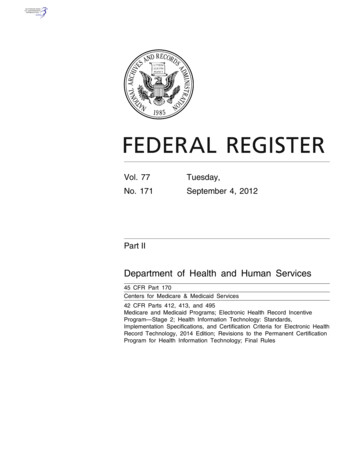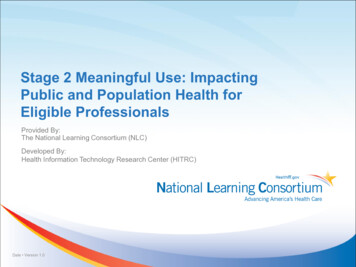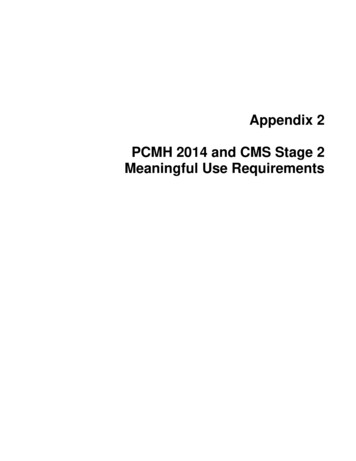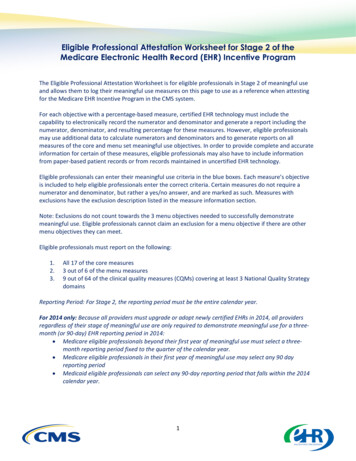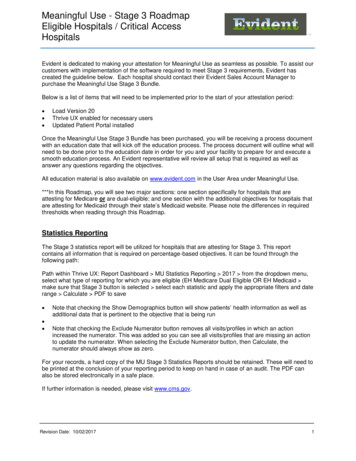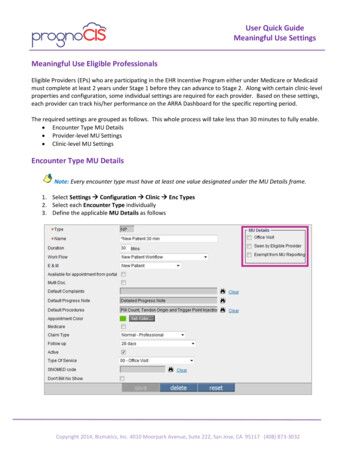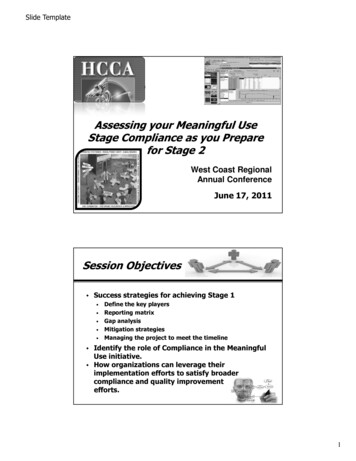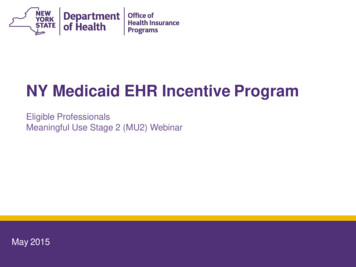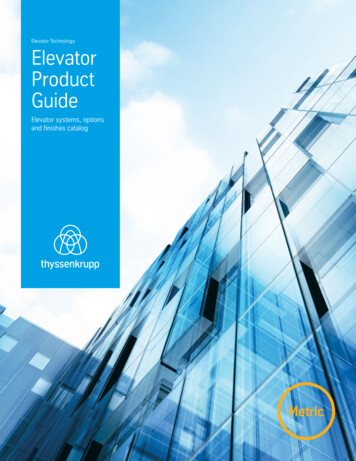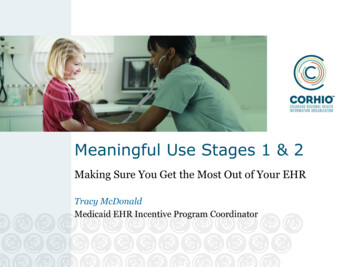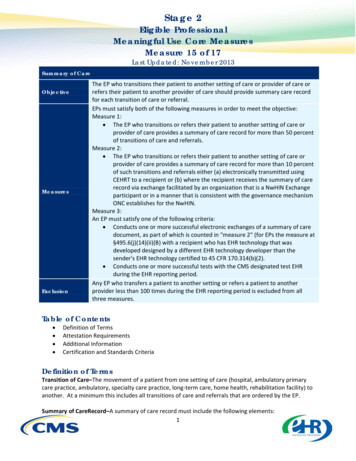
Transcription
Stage 2Eligible ProfessionalMeaningful Use Core MeasuresMeasure 15 of 17Last Updated: August, 2015Summary of CareObjectiveMeasuresExclusionThe EP who transitions their patient to another setting of care or provider of care orrefers their patient to another provider of care should provide summary care recordfor each transition of care or referral.EPs must satisfy both of the following measures in order to meet the objective:Measure 1: The EP who transitions or refers their patient to another setting of care orprovider of care provides a summary of care record for more than 50 percentof transitions of care and referrals.Measure 2: The EP who transitions or refers their patient to another setting of care orprovider of care provides a summary of care record for more than 10 percentof such transitions and referrals either (a) electronically transmitted usingCEHRT to a recipient or (b) where the recipient receives the summary of carerecord via exchange facilitated by an organization that is a NwHIN Exchangeparticipant or in a manner that is consistent with the governance mechanismONC establishes for the NwHIN.Measure 3:An EP must satisfy one of the following criteria: Exchange a summary of care with a provider or third party who has differentCEHRT (and different vendor) as the sending provider as part of the 10%threshold for measure #2, allowing the provider to meet the criteria formeasure #3 without the CMS Designated Test EHR (for EPs the measure at§495.6(j)(14)(ii)(C)(1) with a recipient who has EHR technology that wasdeveloped designed by a different EHR technology developer than thesender's EHR technology certified to 45 CFR 170.314(b)(2).OR If unable to exchange summary of care documents with recipients using adifferent CEHRT in common practice, retain documentation on circumstancesand attest “Yes” to meeting measure 3 if using a certified EHR which meetsthe standards required to send a CCDA (§ 170.202).Any EP who transfers a patient to another setting or refers a patient to anotherprovider less than 100 times during the EHR reporting period is excluded from allthree measures.Table of Contents Definition of TermsAttestation RequirementsAdditional InformationCertification and Standards CriteriaDefinition of Terms1
Transition of Care – The movement of a patient from one setting of care (hospital, ambulatory primarycare practice, ambulatory, specialty care practice, long-term care, home health, rehabilitation facility) toanother. At a minimum this includes all transitions of care and referrals that are ordered by the EP.Summary of Care Record – A summary of care record must include the following elements: Patient name. Referring or transitioning provider's name and office contact information (EP only). Procedures. Encounter diagnosis Immunizations. Laboratory test results. Vital signs (height, weight, blood pressure, BMI). Smoking status. Functional status, including activities of daily living, cognitive and disability status Demographic information (preferred language, sex, race, ethnicity, date of birth). Care plan field, including goals and instructions. Care team including the primary care provider of record and any additional known care teammembers beyond the referring or transitioning provider and the receiving provider. Reason for referral Current problem list (EPs may also include historical problems at their discretion). Current medication list, and Current medication allergy list.Problem List – At a minimum a list of current, active and historical diagnoses. We do not limit the EP tojust including diagnoses on the problem list.Active/current medication list – A list of medications that a given patient is currently taking.Active/current medication allergy list – A list of medications to which a given patient has knownallergies.Allergy – An exaggerated immune response or reaction to substances that are generally not harmful.Care Plan – The structure used to define the management actions for the various conditions, problems,or issues. A care plan must include at a minimum the following components: problem (the focus of thecare plan), goal (the target outcome) and any instructions that the provider has given to the patient. Agoal is a defined target or measure to be achieved in the process of patient care (an expected outcome).Attestation RequirementsDENOMINATOR/NUMERATOR/ THRESHOLD/EXCLUSIONMEASURE 1: DENOMINATOR: Number of transitions of care and referrals during the EHR reporting period forwhich the EP was the transferring or referring provider.2
NUMERATOR: The number of transitions of care and referrals in the denominator where asummary of care record was provided.THRESHOLD: The percentage must be more than 50 percent in order for an EP to meet thismeasure.EXLCUSION: Any EP who transfers a patient to another setting or refers a patient to anotherprovider less than 100 times during the EHR reporting period is excluded from all threemeasures.MEASURE 2: DENOMINATOR: Number of transitions of care and referrals during the EHR reporting period forwhich the EP was the transferring or referring provider. NUMERATOR: The number of transitions of care and referrals in the denominator where asummary of care record was a) electronically transmitted using CEHRT to a recipient or b) wherethe recipient receives the summary of care record via exchange facilitated by an organizationthat is a NwHIN Exchange participant or in a manner that is consistent with the governancemechanism ONC establishes for the nationwide health information network. The organizationcan be a third-party or the sender's own organization. THRESHOLD: The percentage must be more than 10 percent in order for an EP to meet thismeasure. EXCLUSION: Any EP who transfers a patient to another setting or refers a patient to anotherprovider less than 100 times during the EHR reporting period is excluded from all threemeasures.MEASURE 3:YES/NOThe EP attests YES to one of the two criteria:1. Exchange a summary of care with a provider or third party who has different CEHRT (anddifferent vendor) as the sending provider as part of the 10% threshold for measure #2, allowingthe provider to meet the criteria for measure #3 without the CMS Designated Test EHR" (for EPsthe measure at §495.6(j)(14)(ii)(C)(1) with a recipient who has EHR technology that wasdeveloped designed by a different EHR technology developer than the sender's EHR technologycertified to 45 CFR 170.314(b)(2).OR2. If unable to exchange summary of care documents with recipients using a different CEHRT incommon practice, retain documentation on circumstances and attest “Yes” to meeting measure3 if using a certified EHR which meets the standards required to send a CCDA (§ 170.202).Additional Information Only patients whose records are maintained using certified EHR technology must be included inthe denominator for transitions of care.The EP that transfers or refers the patient to another setting of care or provider should providethe summary of care document. It is for this provider that has the most recent information onthe patient that may be crucial to the provider to whom the patient is transferred or referred.3
The EP can send an electronic or paper copy of the summary care record directly to the nextprovider or can provide it to the patient to deliver to the next provider, if the patient canreasonably expected to do so and meet Measure 1.If the provider to whom the referral is made or to whom the patient is transitioned to has accessto the medical record maintained by the referring provider then the summary of care recordwould not need to be provided, and that patient must not be included in the denominator fortransitions of care.To count in the numerator of any measure, the EP must verify these three fields for currentproblem list, current medication list, and current medication allergy list are not blank andinclude the most recent information known by the EP or hospital as of the time of generatingthe summary of care document.To clarify measure #3, some providers are able to conduct cross vendor exchanges in the normalcourse of meeting measure #2, therefore if cross vendor exchanges occurred for measure #2,measure 3 would already be met.To count in the numerator of measure 2, the summary of care record must be received by theprovider to whom the sending provider is referring or transferring the patient.To count in the numerator of measure 2, one of the following three transmission approachesmust be used:o Use of the transport standard capability required for certification. As required by ONCto meet the CEHRT definition, every EP, eligible hospital, and CAH, must have EHRtechnology that is capable of electronically transmitting a summary care record fortransitions of care and referrals according to the primary Direct Project specification(the Applicability Statement for Secure Health Transport). Thus, EPs, eligible hospitals,or CAHs that electronically transmit summary care records using their CEHRT’s “Direct”capability (natively or combined with an intermediary) would be able to count all suchelectronic transmissions in their numerator.o Use of the SOAP-based optional transport standard capability permitted forcertification. As part of certification, ONC permits EHR technology developers tovoluntarily seek certification for their EHR technology’s capability to perform SOAPbased electronic transmissions. EHR technology developers who take this approachwould enable their customers to also use this approach to meet the measure. Thus,EPs, eligible hospitals, or CAHs that electronically transmit summary care records usingtheir CEHRT’s “SOAP-based” capability (natively or combined with an intermediary)would be able to count all of those transmissions in their numerator.o Use of CEHRT to create a summary care record in accordance with the requiredstandard (i.e., Consolidated CDA as specified in 45 CFR 170.314(b)(2)), and the electronictransmission is accomplished through the use of an eHealth Exchange participant whoenables the electronic transmission of the summary care record to its intendedrecipient. Thus, EPs, eligible hospitals, or CAHs who create standardized summary carerecords using their CEHRT and then use an eHealth Exchange participant toelectronically transmit the summary care record would be able to count all of thosetransmissions in their numerator. See related FAQ.In order to meet this objective and measure, an EP must use the capabilities and standards ofCEHRT at 45 CFR 170.314(b)(1), (b)(2), (g)(1), and (g)(2).This exchange may be conducted outside of the EHR reporting period timeframe, but must takeplace no earlier than the start of the year and no later than the end of the EHR reporting year orthe attestation date, whichever occurs first.4
Certification and Standards CriteriaBelow is the corresponding certification and standards criteria for electronic health record technologythat supports achieving the meaningful use of this objective.Certification Criteria*§ 170.314 (b) (1)Transitions ofcare – receive,display, andincorporatetransition ofcare/referralsummaries§ 170.314(b)(2)Transitions ofcare – createand transmittransition ofcare/referralsummaries(i) Receive. EHR technology must be able to electronically receive transition ofcare/referral summaries in accordance with:A. The standard specified in § 170.202(a).B. Optional. The standards specified in § 170.202(a) and (b).C. Optional. The standards specified in § 170.202(b) and (c).(ii) Display. EHR technology must be able to electronically display in humanreadable format the data included in transition of care/referral summariesreceived and formatted according to any of the following standards (andapplicable implementation specifications) specified in: § 170.205(a)(1), §170.205(a)(2), and § 170.205(a)(3).(iii) Incorporate. Upon receipt of a transition of care/referral summary formattedaccording to the standard adopted at § 170.205(a)(3), EHR technology mustbe able to:A. Correct patient. Demonstrate that the transition of care/referralsummary received is or can be properly matched to the correct patient.B. Data incorporation. Electronically incorporate the following dataexpressed according to the specified standard(s): Medications. At a minimum, the version of the standard specified in §170.207(d)(2); Problems. At a minimum, the version of the standard specified in §170.207(a)(3); Medication allergies. At a minimum, the version of the standardspecified in § 170.207(d)(2).C. Section views. Extract and allow for individual display each additionalsection or sections (and the accompanying document headerinformation) that were included in a transition of care/referral summaryreceived and formatted in accordance with the standard adopted at §170.205(a)(3).(i) Create. Enable a user to electronically create a transition of care/referralsummary formatted according to the standard adopted at § 170.205(a)(3)that includes, at a minimum, the Common MU Data Set and the followingdata expressed, where applicable, according to the specified standard(s):A. Encounter diagnoses. The standard specified in § 170.207(i) or, at aminimum, the version of the standard specified § 170.207(a)(3);B. Immunizations. The standard specified in § 170.207(e)(2);C. Cognitive status;D. Functional status; andE. Ambulatory setting only. The reason for referral; and referring ortransitioning provider’s name and office contact information.F. Inpatient setting only. Discharge instructions.5
(ii) Transmit. Enable a user to electronically transmit the transition ofcare/referral summary created in paragraph (b)(2)(i) of this section inaccordance with:A. The standard specified in § 170.202(a).B. Optional. The standards specified in § 170.202(a) and (b).C. Optional. The standards specified in § 170.202(b) and (c).Enable a user to electronically record, change, and access a patient’s problem list:(i) Ambulatory setting. Over multiple encounters in accordance with, at a§ 170.314(a)(5)minimum, the version of the standard specified in § 170.207(a)(3); orProblem list(ii) Inpatient setting. For the duration of an entire hospitalization in accordancewith, at a minimum, the version of the standard specified in § 170.207(a)(3).Enablea user to electronically record, change, and access a patient’s active§ 170.314(a)(6)Medication listmedication list as well as medication history.Enable a user to electronically record, change, and access a patient’s active§ 170.314(a)(7)medication allergy list as well as medication allergy history:Medication(i) Ambulatory setting. Over multiple encounters; orallergy list(ii) Inpatient setting. For the duration of an entire hospitalization.*Depending on the type of certification issued to the EHR technology, it will also have been certified tothe certification criterion adopted at 45 CFR 170.314 (g)(1), (g)(2), or both, in order to assist in thecalculation of this meaningful use measure.Additional certification criteria may apply. Review the ONC 2014 Edition EHR Certification Criteria GridMapped to Meaningful Use Stage 2 for more information.Standards Criteria§ 170.202(a)Transportstandards§ 170.202(b)Transportstandards§ 170.202(c)Transportstandards§ 170.205(a)(1)ONC Applicability Statement for Secure Health Transport (incorporated byreference in § 170.299).ONC XDR and XDM for Direct Messaging Specification (incorporated by referencein § 170.299).ONC Transport and Security Specification (incorporated by reference in §170.299).HL7 Implementation Guide for CDA Release 2, CCD. Implementationspecifications: HITSP Summary Documents Using HL7 CCD Component HITSP/C32.6
Standards Criteria§ 170.205(a)(2)§ 170.205(a)(3)§170.207(a)(3)Problem izations§170.207(i)EncounterDiagnosesASTM E2369 Standard Specification for Continuity of Care Record and Adjunct toASTM E2369.HL7 Implementation Guide for CDA Release 2: IHE Health Story Consolidation.The use of the “unstructured document” document-level template is prohibited.IHTSDO SNOMED CT International Release July 2012 (incorporated by referencein § 170.299) and US Extension to SNOMED CT March 2012 Release(incorporated by reference in § 170.299).RxNorm, a standardized nomenclature for clinical drugs produced by the UnitedStates National Library of Medicine, August 6, 2012 Release (incorporated byreference in § 170.299)HL7 Standard Code Set CVX – Vaccines Administered, updates throughJuly 11, 2012.The code set specified at 45 CFR 162.1002(c)(2) for the indicated conditions.Additional standards criteria may apply. Review the ONC 2014 Edition EHR Certification Criteria GridMapped to Meaningful Use Stage 2 for more information.7
course of meeting measure #2, therefore if cross vendor exchanges occurred for measure #2, measure 3 would already be met. To count in the numerator of measure 2, the summary of care record must be received by the provider to whom the sending provider is referring or transferring the patient.
